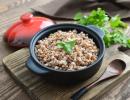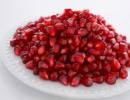What is contained in 100 grams of buckwheat. Buckwheat - benefits, harms and everything you need to know about this cereal
Buckwheat is one of the few products that are genetically close to us. Since from ancient times cereals were the diet of our ancestors, there are practically no allergies to it. It is not surprising that it is buckwheat porridge that often forms the basis of our menu. But what is the calorie content of buckwheat, its BJU and glycemic index? What is the benefit of the product? Let's figure it out together!
The benefits and harms of buckwheat
Why is buckwheat so useful? This cereal has a wide range of positive properties for the human body:
- acts as a natural antioxidant;
- strengthens blood vessels;
- cleanses the body;
- improves heart function;
- removes toxins from the digestive tract;
- normalizes the functioning of the nervous system;
- relieves anxiety;
- lowers cholesterol levels;
- eliminates depression.
Also, this product has a beneficial effect on the liver, removing the load from it. Buckwheat adds endurance, restores physical strength, strengthens the immune system, regulates blood sugar levels. Buckwheat is also an important source of amino acids and protein. It is often included in the diet for anemia and, if necessary, to support the body's defenses.

Daily intake of buckwheat
Not only the benefits, but also the harm of this food is largely due to the amount of product consumed. It is important to remember: the daily need for buckwheat is only 200 grams. The daily rate is advised to be included in the menu in the morning to recharge.
The composition and nutritional value of buckwheat
The benefits of buckwheat are explained by its unique biochemical composition. This cereal is a real storehouse of valuable minerals, vitamins and other components useful for our body. Their content in the product is presented in the table:
| Substance name | Content (in g, mg, mcg) |
| Silicon | 81 |
| Sulfur | 88 |
| Vitamin B9 | 32 |
| Bor | 350 |
| Alimentary fiber | 11,3 |
| Calcium | 20 |
| Vitamin PP | 4,2 |
| Iodine | 3,3 |
| Sodium | 3 |
| Vitamin B2 | 0,2 |
| Chlorine | 33 |
| Starch | 55,4 |
| Vitamin A | 2 |
| Potassium | 380 |
| Titanium | 33 |
| Iron | 6,7 |
| Vitamin B1 | 0,43 |
| Magnesium | 200 |
| Fluorine | 23 |
| Ash | 1,7 |
| Vitamin E | 6,65 |
| Water | 14 |
| Phosphorus | 298 |
| Vitamin B6 | 0,4 |
| Zinc | 2,05 |
| beta carotene | 0,01 |
Here are just a few of the main important elements that are in buckwheat. The product also contains mono- and disaccharides, various types of acids, other macro- and microelements. But when studying the nutritional value of the product, it is worth noting a balanced BJU:
- proteins - 4.2 gr;
- fats - 1.1 gr;
- carbohydrates - 21.3 gr.
The glycemic index of buckwheat is 40 units.
But how many calories are in 100 grams of product? The most useful and dietary way of preparing cereals is on water without boiling. A product soaked and steamed in this way without heat treatment and without salt contains only 90 kcal. The unboiled nutmeg is the most useful and low-calorie option for preparing cereals, and you can brew it directly in a glass or bowl. But the most popular way to cook porridge is standard cooking. After such processing, the core in 100 g of the finished dish without salt or sugar is 105 kcal.
Sprouted kernel "weighs" 198 calories. And if you make steamed porridge, then one serving will be 141.9 units. And what is the energy value of the green variety? In this type of cereal, if it is raw, - 343 kcal. But in boiled form, this figure is only 110 units.
You can get acquainted with the calorie content of cereals prepared in different ways from the table for 100 gr:

How many calories in 100 grams with supplements
When compiling a diet and calculating total calories, it is important to understand that the energy value of buckwheat porridge depends not only on its variety, but also on the additives used. After all, the calorie content of a dry unground and a finished product with mushrooms, butter or milk differs by the same 100 gr.
Very often boiled core is made with milk. But keep in mind: this method of cooking will increase the energy value. How many calories are in 100 grams of milk buckwheat porridge? It all depends on the ratio of milk and base. Therefore, the indicator can vary between 120-200 units.
 Photo source: shutterstock.com
Photo source: shutterstock.com
Boiled in bags "Mistral" or "Uvelka" cereals have the same performance. But salt can increase them. The nutritional value of porridge rises with the addition of such a component by 5 kcal. That is, if there are 105 units in one hundred grams of boiled buckwheat, then with salt it is already 110 kcal.
Another common additive is butter. Most often, porridge is served with butter, less often with vegetable oil. The second option is more high-calorie. This cooking method gives 180 kcal per 100 grams of food. The addition of butter allows you to get a product of 150 units. But so that the porridge does not come out too high-calorie, you should not use a lot of additives (5-10 grams of oil is enough).
You can learn more about the beneficial properties of the kernel from the video:
Content:
What is useful buckwheat. What it consists of - the content of proteins, carbohydrates and fats. The correct recipe.
The benefits of buckwheat have been known for a long time. What are only the positive reviews of athletes and losing weight women. The first take the product to gain muscle mass and get enough energy, and the second - to lose weight.
It is believed that buckwheat is a carbohydrate that can provide the body with the required energy component. But is it only worth adding to the asset of the product?
The homeland of cereals are the regions of Nepal and India, where buckwheat has been eaten for more than four thousand years. As for Russia, the plant came here later and, as you might guess from the name, Greece became the source country.
Buckwheat itself is buckwheat kernels obtained by separating the central part from the shells of the fruit. Depending on the quality of the source and the method of extraction, buckwheat groats are distinguished in three varieties, where the first variety is considered the most "clean" and useful.
Compound
The main advantage of buckwheat is its high content of minerals, the most important of which are:
- iron;
- copper;
- phosphorus;
- iodine, etc.
The product contains 12-13 grams of protein and 60-65 grams of carbohydrates(per 100 gr). In addition, in the composition of the nuclei there was a place for a number of vitamins:
- tocopherol (E);
- vitamins of group B - B2, B6, B9, B1;
- vitamin PP, etc.
Proteins and carbohydrates in buckwheat are not the only components of the product. It also contains fats, but most of them are polyunsaturated, that is, of plant origin. Their presence guarantees a decrease in cholesterol levels and the normalization of metabolic processes. In addition, this is a plus for the figure (no matter how strange it may sound). The product normalizes metabolic processes and reduces the risk of fat deposits.
The proteins that make up the cereal supply a sufficient amount of amino acids, which makes the product truly useful. Proteins of buckwheat in composition almost do not lag behind those that the body receives from meat. If we compare the composition with legumes (beans, peas and others), then cereals are also in the lead here.
The average calorie content of buckwheat is 300-320 kcal. But don't be afraid. Properly cooked porridge is the way to lose weight. Knowing how many carbohydrates are in buckwheat, it is possible to form a diet and eliminate the accumulation of fat. The protein of the kernels contains 18 amino acids, which makes the composition of cereals similar to powdered milk or chicken eggs. The product also contains organic acids that improve digestion.
Let's summarize the composition. For 100 grams of buckwheat you have:
- 12-13 g of protein;
- 3-3.5 g fat;
- 60-65 g of carbohydrates;
- caloric content - 300-320 kcal .;
- water - 13-15 mg.
Indicators of proteins, fats and carbohydrates in buckwheat may vary. A lot depends on the variety and type of roast. And the indicators of buckwheat porridge cooked in milk are much higher.
How to cook buckwheat?
Above it was considered how many proteins, carbohydrates and fats are in cereals. But the content of the mentioned nutrients is influenced by another factor - the correct preparation of the product. Here it is worth following the following algorithm:
- Before cooking, it is recommended to select the stones present in the composition and select low-quality grains.
- After the product is washed under a stream of cold water, which guarantees a quick screening of foreign debris.
- Pour buckwheat and pour water on the basis that the volume of cereals will increase two to three times.
- It is recommended to salt the water immediately after the start of cooking. After the pan is on low heat until boiling. Average cooking time - 15-20 minutes.
- The fire is turned off when there is no more water left at the bottom. After the porridge has cooled, butter is added and the dish is eaten.
- In the evening, cook the cereal - clean it and rinse with water.
- Pour buckwheat into a saucepan and fill with boiled water. After that, it should be infused all night (at least 6-8 hours).
- In the morning, the grains choose water almost completely. If the cereal does not have enough liquid, then it should be topped up.
- Then add salt and put the pan on a small fire until the first bubbles appear.
- That's all - oil is added to the finished dish and served at the table.
Helpful cooking tips:
- During the cooking process, it is forbidden to interfere with the kernels and open the lid unnecessarily.
- It is easiest to sort out grains in containers with a wide bottom. In this case, the cereal will be distributed over the surface and bad buckwheat is easier to weed out.
- For a better taste, the kernels should be fried before cooking.

Buckwheat and diet
Many people still argue: is buckwheat a carbohydrate or protein? In fact, each of these elements is present in abundance. The main plus of the kernels is not only the presence of vitamins and minerals, but also the absence of harmful substances (artificial fertilizers and pesticides). The vegetable protein contained in the dish is a good substitute for animal protein. In addition, buckwheat is different low glycemic index due to the presence of slow carbohydrates in the composition.
The use of buckwheat provides a long-lasting feeling of satiety, which is useful during the diet. There is also fiber in the composition, which eliminates a sharp increase in blood sugar levels. Ideally, replace wheat flour with buckwheat flour, which has a better taste and is quickly digested in the stomach.
For those who are wondering if there are a lot of carbohydrates in buckwheat, there is an excellent solution - to cook the product without sauce, sugar and oil. Such a diet helps to remove excess water from the body, helps to tighten muscles and skin. Due to the healing properties of the dish, doctors often include it in the diet of obese or diabetic patients. Also, buckwheat porridge is useful for diseases of the heart and kidneys, during pregnancy or lactation. 
Results
When asked if there are carbohydrates in buckwheat, nutritionists answer in the affirmative. But it is worth remembering that the composition contains only complex carbohydrates that are safe for the figure. So, with the proper organization of the diet, this cereal can save from the accumulation of fat, protein deficiency, lack of vitamins and minerals. This product is a real miracle that should be on the table of every person.
The popularity of buckwheat is determined not only by the fact that the calorie content of boiled buckwheat is quite low, but also by how unique and rich the composition of buckwheat is per 100 grams. It includes vitamins, minerals, amino acids that play a vital role for the human body. In the article we will consider the composition of buckwheat: proteins, fats, carbohydrates, the amount and ratio of which is especially important for athletes and losing weight people.
Nutritional value of buckwheat per 100 grams
The nutritional value of buckwheat compared to other cereals is distinguished by the ratio of proteins, fats and carbohydrates. The nutritional value of buckwheat in 100 grams contains:
- Fats - 0.9 gr;
- Proteins - 3.5 gr;
- Carbohydrates - 15.9 gr;
- Water - 73.3 gr;
- Unsaturated fatty acids - 0.2 gr.
Athletes are most often interested in how many proteins are in buckwheat. In dry form, this cereal has 12.6 grams of protein per 100 grams of product. The chemical composition of boiled buckwheat contains 3.5 grams of protein.
Another value of the composition of buckwheat per 100 grams is the low content of saturated fats, the absence of cholesterol, sugar, a large amount of fiber, slow carbohydrates, which give a feeling of satiety for a long time. That is why buckwheat diets are very popular all over the world. Athletes also appreciate this cereal for the nutritional value of boiled buckwheat.
The nutritional value of buckwheat in finished form is very high, it is compared even with meat. The amount of amino acids in this cereal is comparable to peas, beans and other legumes. Proteins in buckwheat are contained in almost the same amount as in eggs or milk powder.
The glycemic index of buckwheat is 55 units out of 100. This suggests that when eating cereals, blood sugar levels do not increase quickly. The result is nutrient absorption without excess being stored as fat.
For convenience, we present a table indicating the nutritional value of dry buckwheat per 100 grams:
Video
The composition of buckwheat per 100 grams
The chemical composition of buckwheat is no less striking than the nutritional value of buckwheat in 100 g. Vitamins, macro and microelements that are beneficial for the human body are present in large quantities in this cereal.
The composition of raw and boiled buckwheat is rich in B vitamins necessary for protein, carbohydrate, lipid and water-salt metabolism. This group of vitamins is important for the brain and nervous system. The composition of buckwheat, compared to other cereals, is especially rich in vitamin P, which is necessary for the heart, thyroid gland, and arterial walls. The composition of boiled buckwheat does not contain gluten (gluten), which is especially important for people with allergic reactions to this substance. Other cereals (wheat, rye, oats, barley) contain gluten.

The energy and nutritional value of buckwheat boiled in water is high due to the correct balance of the biochemical composition. We recommend regularly including cereals in the diet to normalize digestion, cleanse the body, and restore the balance of trace elements. This is especially important for weight loss, the composition of buckwheat will also be useful for people suffering from obesity, diabetes, atherosclerosis, diseases of the cardiovascular system and gastrointestinal tract.
You can study in detail the chemical composition of buckwheat per 100 grams using the table:
| Vitamin PP | 4.2 mg |
| Vitamin E | 6.65 mg |
| beta carotene | 0.01 mg |
| Vitamin A (RE) | 2 mcg |
| Vitamin B1 (thiamine) | 0.43 mg |
| Vitamin B2 (riboflavin) | 0.2 mg |
| Vitamin B6 (pyridoxine) | 0.4 mg |
| Vitamin B9 (folic) | 32 mcg |
| Vitamin E (TE) | 0.8 mg |
| Vitamin PP (Niacin equivalent) | 7.2 mg |
| Iron | 6.7 mg |
| Zinc | 2.05 mg |
| Iodine | 3.3 mcg |
| Sulfur | 88 mg |
| Chlorine | 33 mg |
| Phosphorus | 298 mg |
| Potassium | 380 mg |
| Sodium | 3 mg |
| Magnesium | 200 mg |
| Calcium | 20 mg |
| Copper | 640 mg |
| Manganese | 1.56 mg |
| Selenium | 8.3 mcg |
| Chromium | 4 mcg |
| Fluorine | 23 mcg |
| Molybdenum | 34.4 mcg |
| Bor | 350 mcg |
| Silicon | 81 mg |
| Kolbat | 3.1 mcg |
| Nickel | 10.1 mcg |
Buckwheat combines two paradoxical qualities. An unusually satisfying and nutritious product - at the same time, it is truly low-calorie and is perfect even for very strict diets. The reason for this is the high content of proteins and complex carbohydrates, which makes buckwheat dishes extremely useful for people who lead an active lifestyle and go in for sports.
| |Calorie boiled and raw buckwheat
We suggest that you familiarize yourself with two comparative tables of the calorie content of buckwheat. The first table contains calorie data boiled buckwheat porridge without additives, and the second - about the nutritional value raw cereal.
In 100 grams boiled buckwheat contains*:
nutritional value 50 gr boiled buckwheat- 55 kcal. Proteins: 2.1g, Carbohydrates: 10.65g, Fats: 0.55g.
100 grams of raw buckwheat contains:
*Calorie content of boiled buckwheat and the ratio of BJU depends on the method of its preparation and the amount of water.
The table shows indicative figures. The nutritional value of 100 grams of ready-made porridge cooked with water and without adding oil, as a rule, does not exceed 110 kcal.
Thus, 100 grams of raw buckwheat (which is usually what is needed to prepare one or two servings of porridge) contains only 330 kilocalories, which is only 13.2% of the daily requirement of an adult (2500 kcal).
All useful properties of buckwheat
Buckwheat porridge and other buckwheat dishes are good for our health and well-being due to their balanced composition and high nutritional value. At the same time, one should not think that the nutritional value of buckwheat porridge is a consequence of high calorie content. Far from it - the secret of nutrition lies in the large amount of "slow" carbohydrates and high-grade, easily digestible proteins in its composition.
In no case should you be afraid of a relatively large number carbohydrates in raw cereals. As we mentioned above, buckwheat does not contain at all, which lead to sharp fluctuations in the level of "sugar" in the blood. All carbohydrates contained in buckwheat are slow, which means that one serving of buckwheat porridge will create a long-term feeling of satiety, despite the low energy value. Thereby Buckwheat porridge is great for weight loss and can be included in a healthy breakfast, which will help to avoid feeling hungry until lunchtime.
The most valuable nutritional components of buckwheat for people actively involved in sports, and, first of all, weightlifting, are proteins (proteins). Here they contain as much as 12.6 grams per serving. At the same time, the amino acid composition of proteins is one of the richest and most balanced among plant foods. Buckwheat proteins contain a large number of important amino acids - lysine and methionine. At the same time, buckwheat proteins are highly digestible, which makes this cereal indispensable in the diet of athletes to accelerate muscle recovery after training.
Very often, buckwheat is used as a temporary substitute for meat and other sources of animal proteins. For the same reason, this cereal enjoys stable popularity among vegetarians, for which its rich amino acid profile is especially important.
Concerning fat, then there are very few of them in buckwheat - only 3.3 grams per serving. At the same time, there are no harmful saturated fats at all. However, it is not in vain that the proverb says that "You can't spoil porridge with butter." For better absorption and a more pleasant taste of buckwheat porridge, it is better to add a small amount of vegetable oil to it (flaxseed oil will be especially useful due to the high amount of OMEGA-3 and will perfectly complement the taste) or initially cook not in water but in milk. You can fry a portion of porridge with two eggs a little more, so it will become even more tasty and crumbly.
Mineral composition and vitamins
Now that we have found out how many calories are in dry and boiled buckwheat, let's move on to the mineral composition and vitamins contained in it.
Buckwheat contains important water-soluble B vitamins, which, unlike fat-soluble vitamins, must be supplied to our body daily, because. do not accumulate in it. In terms of minerals, buckwheat is certainly one of the leaders in terms of iron content. However, we must remember that the iron that we get from plant foods is absorbed much worse than from animal products. If you are a vegetarian, you should consider taking additional vitamin and mineral supplements with iron.
In general, buckwheat cannot be called rich in minerals and vitamins. For this reason, we do not recommend “sitting” on the popular “buckwheat diet” for a long time, because. for all its beneficial properties and nutritional value, a lack of vitamins can lead to beriberi and many other unpleasant consequences. As they say, everything is good in moderation.
And only as part of a varied diet, buckwheat shows all its beneficial properties. Buckwheat porridge is an excellent and balanced dietary product that can be safely recommended for regular consumption by absolutely everyone - both children and women and bodybuilders who want to lose weight and maintain body weight (it is especially useful to eat buckwheat a few hours before strength training, because it gives a long feeling of satiety) and athletes and, of course, the elderly.






